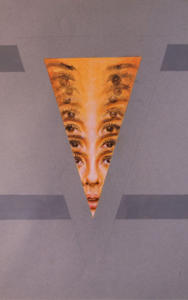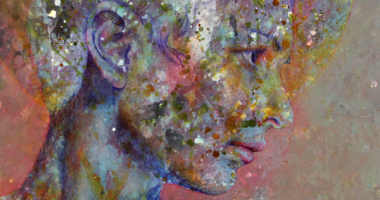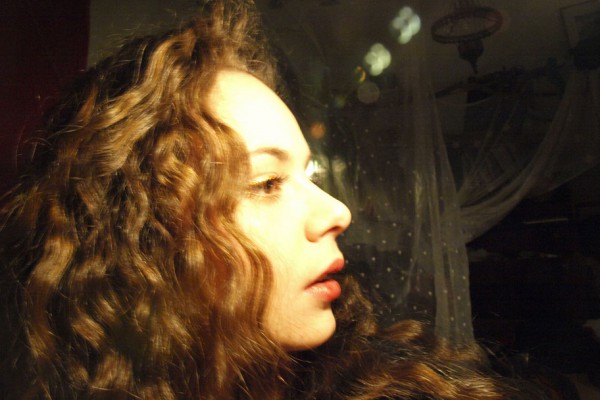
28 und etwas aus der Zeit gefallen – die Hamburger Künstlerin und Illustratorin Nuria Paz entzieht sich moderner Kommunikationsmittel wie Facebook, Twitter und Co. Das im Grafikdesign weit verbreitete digitale Zeichnen und Malen ist ebenso wenig ihr Ding. Die Deutsch-Argentinierin liebt den direkten Kontakt mit Menschen wie mit ihren Arbeitsutensilien: Sie bespannt ihre Leinwände selber, mischt Farben an, sammelt Bilder aus Magazinen. Als freie Künstlerin schafft sie damit Unikate. Für ihre Arbeit als Illustratorin werden aus solchen Unikaten eingescannte, am Computer teilweise vervollständigte und reproduzierbare Werke. Eines davon ist das Poster für das Fever Creek Festival 2014.
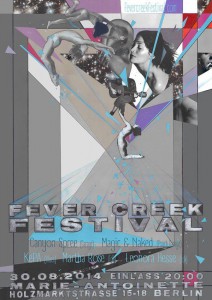 Das Plakat (links) ist nahezu 100 Prozent handgemacht. Nur wenige Schriftzüge wurden am Computer hinzugefügt. Im Design spiegeln sich einige wichtige Merkmale von Nuria Paz’ Arbeit wieder: Sie ist detailverliebt, verbindet Malerei und Collage und enthält realistische Elemente, die sich im Irrealen verlieren.
Das Plakat (links) ist nahezu 100 Prozent handgemacht. Nur wenige Schriftzüge wurden am Computer hinzugefügt. Im Design spiegeln sich einige wichtige Merkmale von Nuria Paz’ Arbeit wieder: Sie ist detailverliebt, verbindet Malerei und Collage und enthält realistische Elemente, die sich im Irrealen verlieren.
Zwischen 2009 und 2013 erlernte Nuria Paz das Handwerk der Illustration an einer Privatschule. Für das Studium zog die damals 23-Jährige vom Schaumburger Land nach Hamburg und blieb. Sie mag den Großtstadtvibe, die Möwen, den Hafen und die Menschen.
Menschen sind auch wichtiger Bestandteil ihrer Bilderwelt, egal ob auf Gemälden, in Collagen oder anderen Designs. In einer ihrer ersten Auftragsarbeiten, die Gestaltung des Jahrbuches “100 Jahre Bananen Import”, überzeugt sie den Kunden Port International aus Hamburg mit einer Reihe von Collagen. Sie erzählen die Liebesgeschichte zwischen einer Kolumbianerin und einem Bananen-Importeur. In einem aktuellen Projekt porträtiert sie Bekannte aus dem Hamburger Stadtteil St. Pauli. Außerdem arbeitet sie an zwei Auftragsporträts. Die Personen sind – wie in vielen ihrer Arbeiten – realistisch dargestellt, während der Hintergrund diffus bleibt.
Religion spielt eine ebenso entscheidende Rolle in ihrer Arbeit. Dabei interessiert sie weniger eine klassisch-sakrale Darstellung. Für die freie Serie “Photopsy” – Lichterscheinungen – stellt sie Menschen aus dem Hier und Jetzt als Heilige dar. Über ihren Köpfen schwebt ein zart gemalter Heiligenkranz und ihre Haut wirkt lichtdurchlässig. Um diese Effekte zu erzielen, setzt Nuria Paz vor allem Gouache, Aquarell und aus Eigelb selbst hergestellte Temperafarben ein. In einem zukünftigen Projekt will sie die sieben Todsünden illustrieren, erneut modern interpretiert.
Nuria Paz mag sich einigen technischen Trends entziehen, aber ihre Art, Kunst zu machen, ist alles andere als rückständig. Im Gegenteil: Sie verbindet auf unaufgeregte Weise das Moderne mit dem Klassischen. Ein Kurzinterview mit Nuria Paz.
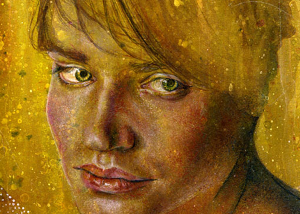 Deine Arbeitsweise ist für heutige Zeiten, in denen das Digitale auch im Design allgegenwärtig ist, ungewöhnlich. Du machst vieles in Handarbeit. Was bedeutet dir diese Vorgehensweise?
Deine Arbeitsweise ist für heutige Zeiten, in denen das Digitale auch im Design allgegenwärtig ist, ungewöhnlich. Du machst vieles in Handarbeit. Was bedeutet dir diese Vorgehensweise?
Für mich ist die Vorbereitung, vom Leinwand aufspannen über Farben mischen, vom Buntstifte anspitzen, übrigens mein Lieblingsgeruch, über Magazine sammeln für Collagen, eine sinnlich-mentale Einstimmung. In Zeiten des schnell Abrufbaren zelebriere ich den Weg, der die Bahn legt für die haptische Umsetzung. Oder ich bin einfach old-school.
Wann hast du die Liebe zur Kunst entdeckt?
Als Zuflucht für einen Teenager, der immer auf der Suche nach seinem eigenem Ausdruck ist, habe ich letztendlich in der Malerei mein persöhnliches Ventil gefunden. Ansonsten bin ich einfach ein sehr visueller Mensch. Schöne Dinge bereiten mir schon immer Freude, egal ob in der Kunst oder im Alltag – und ist das nicht irgendwo auch dasselbe!?
Räumlich machst du jedenfalls keine Trennung – dein Atelier ist Teil deiner Wohnung. Wie sieht es dort aus?
In meinem Arbeitszimmer fehlt es mir an nichts. Ich könnte darin monatelang überleben. Abgesehen vom Elementaren wie meinen Arbeitsutensilien gibt es dort viele Design- und Kunstbücher aus zweiter Hand, Fotos von Freunden und Familie, ein bisschen von Flohmärkten zusammen gesammelter Schnickschnack, einfach so zum Betrachten und Spaß dran haben. Die Musik läuft über meinem Laptop und wenn’s einmal spät wird, öffne ich einen leichten Küchenwein. Außerdem streichen die Katzen Poppidu und Minza durch die Gegend und vermitteln den Eindruck von Normalität.
Wie gehst du bei der Umsetzung von einer Idee zum Bild vor – intuitiv oder nach Plan?
Ein Bild ist wie eine Reise. Am Anfang hast du ein Ziel und kannst einfach geradeaus gehen. Aber dann biegste mal rechts ab, nur um zu gucken, wie die Aussicht ist, und merkst, dass die Perspektive gar nicht so schlecht ist. Manchmal verliert man sich im Kreis, manchmal verliert man unterwegs das Gepäck. Am Ziel angekommen ist man trotzdem irgendwann und denkt dann: wat ‘ne schöne Reise.
>> GO HERE TO SEE THE ART OF NURIA PAZ <<
28 years of age and a little bit behind the times – Hamburg based artist and illustrator Nuria Paz eludes herself from modern communication tools like Facebook, Twitter and Co. That in graphic design widely used digital drawing and painting is just as little her thing. The German-Argentine loves the direct contact with humans as well as with her working utensils: She covers her canvas by herself, likes to mix paint and collects pictures from magazines. As a free artist she creates therewith unique pieces. For her work as an illustrator those unique works are turned into scanned, from time to time digital edited and reproducible pieces. One of them is the poster of the Fever Creek Festival 2014.
The poster (above) is almost 100 percent handmade. Just a few letterings were added on the computer. The design reflects a lot of typical characteristics of Nuria Paz work: It is full of details, connects painting and collage and is composed of realistic elements that get lost in the unreal.
Between 2009 and 2013 Nuria Paz learned the craft of illustration at a private school. For her studies the back then 23 years old moved from the Schaumburger Land to Hamburg and ended up staying. She likes the vibe, the seagulls, the harbor and the people.
People are also a main part in her imagery, regardless if on canvas, in collages or other designs. In one of her first commissioned work, the design of the yearbook “100 years of banana import”, she convinced her client Port International from Hamburg with a series of collages that tell the love story between a columbian woman and a banana importer. In the current project “Suburban” she portraits acquaintances of the district St. Pauli in Hamburg. Furthermore, she works on two commissioned portraits at the moment. The persons are – like in many of her works – depicted realistic whereas the background stays hazy.
Religion plays also a decisive role in her work. She is, however, less interested in the classic-sacred depiction. For her series “Photopsy” – light phenomenon – she portraits people of the here and now as saints. Above their head is a halo, drawn in a tender manner, their skin seems to be translucent. To get this effect, Nuria Paz uses especially gouache, aquarelle and temperas made out of egg. In a future project, she wants to illustrate the seven dead sins, again interpreted in a modern way.
Nuria Paz might try to evade certain technical trends, but her way of making art isn’t backward at all. On the contrary: She connects nonchalantly modernity with the classic. A short interview with Nuria Paz.
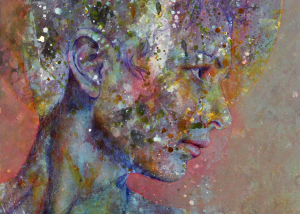 Your work method is for contemporary times quite uncommon where the digital is widely used in design. You do a lot by hand. How important is this way of working for you?
Your work method is for contemporary times quite uncommon where the digital is widely used in design. You do a lot by hand. How important is this way of working for you?
For me the preparation – starting with covering the canvas, mixing colors, sharpening colored pencils, my favorite smell by the way, to collecting magazines for collages – is a sensual, mental attunement. In times of the very quickly available I celebrate the journey that lays the foundations for the haptic realization. Or maybe I am just old-school.
When did you discover your love for art?
Being a teenager I was always looking for my own way of expression and I found in painting my personal valve. Apart from that I am just quite a visual person. Beautiful things always got my attention, in art and the daily business – and isn’t that somehow the same anyways?
You do not separate spatially – your studio is part of your apartment. How does it look like?
In my work room I do not miss anything. I could survive there for several months. Apart from the elementary like my working utensils I have there a lot of second hand design and art books, pictures of family and friends on the walls, a little bit of knickknacks that I collected on flea markets, just to look at and enjoyment. Music comes out of my laptop and when it’s getting late I open a kitchen wine. Additionally my two cats Poppidu and Minza roam around the apartment that give an impression of normality.
How do you realize an idea into a picture – intuitive or do you work according to a plan?
A picture is like a journey. At the beginning you have a certain destination and you can walk straight on. But then you take a turn just to get another view and you realize that the new found perspective is quite good. From time to time you go round in circles, sometimes you lose your luggage. In the end you always reach your destination and you think: what a nice journey!
